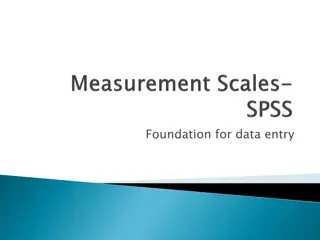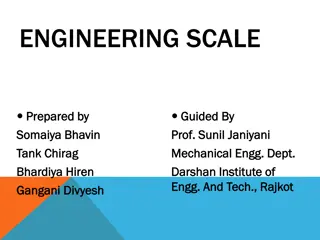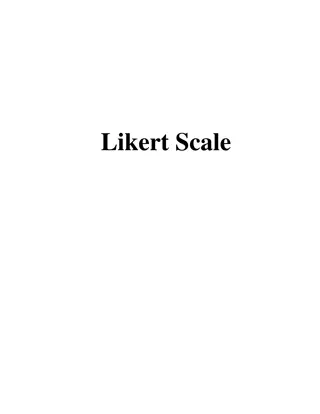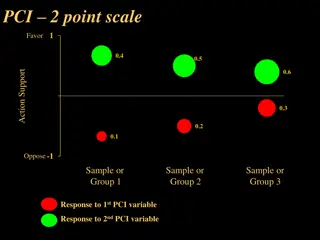Types of Measurement Scales and Their Properties
This paper delves into the types of measurement scales in data analysis: nominal, ordinal, interval, and ratio scales. Each scale is defined and explained in detail, highlighting their unique characteristics and uses in research. The paper also explores how each scale is applied in different scenarios, providing a comprehensive overview of measurement scales in statistical analysis.
Download Presentation

Please find below an Image/Link to download the presentation.
The content on the website is provided AS IS for your information and personal use only. It may not be sold, licensed, or shared on other websites without obtaining consent from the author.If you encounter any issues during the download, it is possible that the publisher has removed the file from their server.
You are allowed to download the files provided on this website for personal or commercial use, subject to the condition that they are used lawfully. All files are the property of their respective owners.
The content on the website is provided AS IS for your information and personal use only. It may not be sold, licensed, or shared on other websites without obtaining consent from the author.
E N D
Presentation Transcript
ICT/Data Analyses By Prof. Geraldine Ugwuonah Department of Marketing University of Nigeria, Enugu Campus
This paper into three parts namely: Measurement and Scaling Data preparation Data Analysis
A nominal scale A nominal scale is the simplest type of scale. The numbers or letters assigned to objects serve as labels. For example, names, player list, and gender.
An ordinal scale An ordinal scale arranges objects in an ordered relationship. Most ordinal scales through ranking. Ordinal scales answers the question of whether objects possess more or less of what is being question of how much member of the same category differ from the other. are obtained measured not
Interval Scale In interval scales, the numbers obtained represent equal increment of the attribute being measured. They also measure the order or distance in units of equal intervals. Only ratio of differences in scale values has meaning and not ratio of absolute scale value.
Interval Scale Contd. The location of .the zero point in interval scale is arbitrary. An example of an interval scale is the temperature where the initial point is arbitrary.
Ratio Scale Ratio scales have absolute rather than relative quantities. The absolute zero represents a point on the scale where there is an absence of the given attribute. Examples include, age, money and weights are ratio scales because they possess an absolute zero.
Types of scales and their properties Types of Measurement Scale Types of Attitude Scale Rules Number for Assigning Typical Application Statistics/Statistical Tests Nominal Dichotomous yes or no scales Objects are either identical different Classification (by sex, geographic social class) Percentages, mode/chi-square or area, Ordinal or rank order Comparative, category, paired comparison rank order itemized Objects are greater or smaller Rankings (preference, class standing) Percentile, Friedman ANOVA medium rank-order Interval Likert, Thurston, stapel, associative, semantic-differential intervals adjacent ranks are equal between Index temperature attitude measures number, scales, Mean, standard deviation, product moment correlations,/t-test, ANOVA, regression, analysis. factor Ratio Certain scales with special instruction There meaningful zero, so comparison absolute magnitudes possible is a Scales, incomes, units produced, cost, age. Geometric and harmonic mean, coefficient of variation. standard deviation, moment correlations,/t-test, ANOVA, regression factor analysis. Mean, product of is
Data Preparation Data preparation involves four major activities. The are as follows: Data editing Data cleaning Data coding Data adjustment and replacement of missing data.
Data Editing Data editing helps to locate for the following : Inconsistent or out of range responses. Omissions: When respondents intentionally or unintentionally fail to answer some questions. Ambiguity: When it is unclear as to which option the respondent chose. Lack of Cooperation: When respondents refuse to follow the instruction and ticks arbitrarily. Ineligible respondents: When a respondent who is not qualified to be in the sample is found in it.
Data coding Data coding translates responses into values suitable for computer entry and statistical analysis.
Example of Coding Question Number Question Description Range of Permissible Values ID NO. OF Questionnaire 001-150 1 Do you eat indomie 0 = no, 1 = yes, 9 = blank 0 = husband, 1 =Myself, 2 = father, 3 = mother, 4 = relative, 5 = friend, 6 = other, 9 = blank. 2 Who is buys it for you? 3 Where do you buy it? service 1= supermarket, 2=open market, 9=blank 0 = less than 1 month, 1 = three months, 2 = six months, 3 = year, 4 = other, 9=blank 4 How often do you buy indomie? 5=to a very large extent, 4= to a large extent, 3=to a fair extent, 2=to a low extent, 1=to a very large extent, 9=blank To what extent are satisfied with the flavour of indomie? 5
Questions that Underlie Coding Decisions The following questions underlie coding decisions: What information exists? What information is relevant? How is it likely to be analyzed? What options exist? Does the question require a multiple response or not? How much of this information should be coded and keyed? How to code open-ended questionnaire items etc.
Data cleaning Once the data have been keyed in, they are subjected to a series of computer checks to clean them. The following checks are obtained through frequency distribution as single table or cross tabulation. Range checks Consistency checks
Range Checks In range checks we do the following: Detect and correct invalid values Note and investigate unusual values Note outliers (even if correct the presence of these data may have a bearing on which statistical methods to use) Reasonableness of distributions
Consistency checks Consistency checks examine pairs of related data items . Detect and correct impermissible combinations. Note and investigate unusual combinations.
Data Adjustment and replacement of missing cases The following SPSS procedures are available for replacing missing cases. Serial Mean: Replaces missing data items by the serial mean of the all the valid cases within the given data set. Mean of nearby points: Replaces missing data items are replaced by the mean of valid surrounding data items. Median of nearby points: Replaces missing data items are replaced by the median of valid surrounding data items. Linear interpolations: Linear trend at point: This procedure replaces missing values with linear trend for that point
Data Analysis There are two major aspects of data analysis, namely: Descriptive and Inferential data analysis.
Descriptive Data Analysis Used to describe the basic features of the data in a study. Provide simple summaries about the sample Examples are: count, mean, median, mode and measures of dispersion like variance and standard deviation. Descriptive statistics may present data in tables, cross tabulations and/or graphs.
Inferential Statistics Under inferential statistics, we need to discuss the rudiments of hypothesis testing, types of groups and different types of statistical tests.
Hypothesis Testing The role of chance is played by a suitable probability model, chosen to represent the probability structure of the data. This leads to error in hypothesis testing. There are two types of error, namely type I and type II error.
Hypothesis Testing Contd. Type I error ( ): The probability of committing the error of rejecting H0 or erroneously rejecting H0 where H0 should not be rejected (i.e., conclude, incorrectly, that data are not consistent with the model). Type II error ( ): The probability of committing the error of failing to reject H0 or erroneously fail to reject H0 (i.e., conclude, incorrectly, that data are consistent with the model). H0 should be rejected. If the probability is low then the final decision is that Ho correctly not rejected.
Types and Nature of Group One group situation. Two group situation. More than two groups.
Nature of groups Independent groups: These are groups that have separate populations. i. ii. Matched groups: These are groups whose populations are not separate or are non-independent.
Common Statistics Used in Business and Social Science Research Chi-square t-test Analysis of variance (ANOVA) Correlation analysis Regression analysis Discriminant analysis Factor analysis
Chi-square as test of independence Chi square test of independence can be performed when interested in finding out if two variables in a given sample has relationship. Example is if a relationship exist between income group type. Chi This is found under cross tabulation statistics in SPSSWIN. a researcher is and housing
The Chi-Square Goodness of Fit test Suppose 100 persons who visit ShopRite are expected to be drawn equally from 5 layouts of Enugu. The expectation is that 20 of the respondent should come from each of the layout. This number is known as the expected frequency. But in reality the respondent are distributed as follows within the layout; 20, 30, 15, 25 and 10. A chi-square for goodness of fit can be used to see if there is any difference between the observed and expected frequency of the 100 persons.
Independent Sample t-test A research was carried out to find out if there is a significant difference on average weekly amount spent on calls by Law students and Business students on. An independent sample t-test can be used to handle this. Administration
Matched group t-test If the researcher further wishes to find out the difference in the mean amount spent of on calls and for management student. A pair of data is obtained from one respondent and this data set may be analyzed using paired sample or matched group t-test. data plan for M.sc
One way Anova The case of one-way anova is the same with independent sample t- test except that more than one group or one sample is involved.
Two way Anova The case of two-way anova is the same with one-way anova except that more than one is involved. In the earlier example another factor other than Department is include. Employment status can be added as a second factor. Factors are usually of nominal scale type. Interaction effect is always sought in a two-way ANOVA
Correlation analysis Correlation technique association of relationship between two or more variables. Precisely, it tries to ascertain the degree of associations between the variables. analysis used is statistical study a to linear
Regression analysis Regression evaluating relationship variable traditionally know as Y-variable (regressand) and variable traditionally variable/s (regressor/s). is statistical establishing between a tool for the or one dependent the independent known as X-
Discriminant analysis This is similar to regression analysis. The only difference is that in discriminant analysis, the dependent variable are fixed while the independent variables follow a normal distribution. But in the case of regression, variables follow a normal distribution the independent variable is fixed. the dependent
Canonical correlation analysis A researcher organizational corporate reputation. This is different from the situation found in multiple regression where there is only one dependent and variables. This is a case of several dependent and several independent variables. Two linear functions are formed which are known as canonical variables and the investigator will seek to find out if significant relationship exist between scores from these functions. wants performance to correlate with measures measures of of many independent
Factor analysis Factor analysis is a statistical technique whose common objective is to represent a set of variables in terms of a smaller number of hypothetical variables. That is, it assumes the existence of a system of underlying factors and a system of observed variables, which is linearly dependent on the underlying factors. It assumes that there is a certain correspondence between these two systems correspondence to arrive at conclusions about the level of influence underlying variables to the observed variables. and exploits this of the respective























